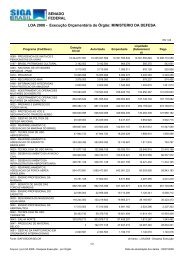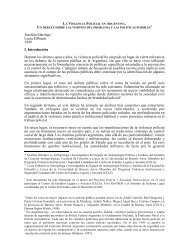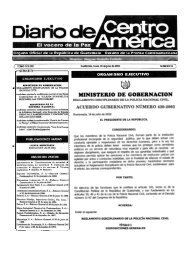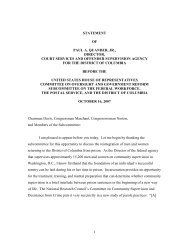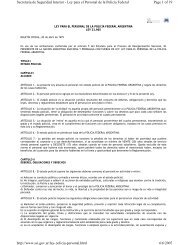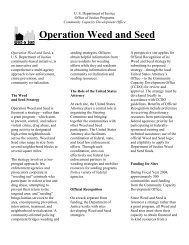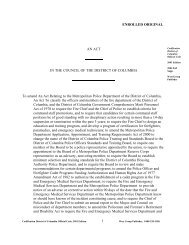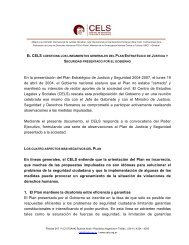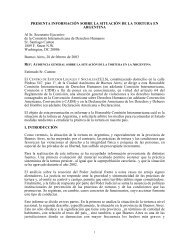Know Your Rights: Domestic Violence Brochure - American Bar ...
Know Your Rights: Domestic Violence Brochure - American Bar ...
Know Your Rights: Domestic Violence Brochure - American Bar ...
You also want an ePaper? Increase the reach of your titles
YUMPU automatically turns print PDFs into web optimized ePapers that Google loves.
KNOW YOUR RIGHTS<br />
<strong>Domestic</strong><br />
<strong>Violence</strong><br />
CONOZCA SUS<br />
DERECHOS<br />
La violencia<br />
doméstica<br />
For immediate help call<br />
National <strong>Domestic</strong><br />
<strong>Violence</strong> Hotline<br />
1-800-799-SAFE or<br />
1-800-787-3224 TTD
You CAN do something about domestic violence<br />
<strong>Domestic</strong> violence is a pattern of many behaviors<br />
directed at achieving and maintaining power and<br />
control over an intimate partner, such as physical<br />
violence, emotional abuse, isolation of the victim,<br />
economic abuse, intimidation, and coercion and<br />
threats.<br />
If someone is abusing you or someone in your<br />
household, you do not have to accept it—even if<br />
your spouse is the abuser. The police and courts<br />
can help you stop the abuse.<br />
Where can you get help in an emergency?<br />
In a crisis situation, call 911 or the police.<br />
Many hospitals and social service agencies help<br />
victims of domestic violence. Look in the Yellow<br />
Pages under “domestic violence help,” “domestic<br />
violence shelters,” “human services organizations,”<br />
or “crisis intervention” or search these terms and<br />
your locality on an Internet search engine. In addition,<br />
every state has a coalition against domestic<br />
violence. These coalitions can be valuable resources<br />
for victims of domestic violence seeking services<br />
and referrals. You can also call the National<br />
<strong>Domestic</strong> <strong>Violence</strong> Hotline at 1-800-799-SAFE or<br />
1-800-787-3224 TTD for immediate help.<br />
It is important that you develop a safety plan to protect<br />
yourself and your children in the case of an<br />
emergency. Agencies, advocates, and shelters that<br />
assist victims of domestic violence can help you<br />
develop your safety plan. It is also important to<br />
update your safety plan as needed to address<br />
changing circumstances or new concerns.<br />
<strong>Domestic</strong> violence is against the law<br />
It is a crime in all states, though each state’s laws<br />
are a little different.<br />
Abuse can include:<br />
• physical attacks, including forced sexual relations<br />
• verbal abuse or harassment, including disrespectful<br />
or demeaning comments
• threats against you or another family member<br />
• creating disturbances at your place of work<br />
• harassing telephone calls<br />
• spying on you<br />
• child abuse<br />
<strong>Domestic</strong> violence can be handled in three different<br />
types of courts:<br />
• criminal court, where the state will prosecute<br />
the abuser (possible crimes include abuse of<br />
intimate partner, violation of a protection order,<br />
elder abuse, murder, rape, assault, kidnapping,<br />
false imprisonment, property destruction, vandalism,<br />
trespassing, stalking, unlawful possession<br />
or concealment of a weapon, intimidating a<br />
witness, and many others)<br />
• civil court, where you might address violation of<br />
a protection order or sue for money damages<br />
(possible civil lawsuits include sexual harassment,<br />
personal injury)<br />
• divorce, or family, court (family violence directly<br />
affects divorce proceedings and can be a factor<br />
in limiting or prohibiting the abuser’s rights to<br />
child custody or visitation privileges)<br />
<strong>Domestic</strong> violence might also involve child abuse<br />
and neglect and might impact on other areas of law,<br />
such as public benefits, immigration status, etc.<br />
A Court Order of Protection<br />
<strong>Your</strong> fastest form of legal help is to get a Court<br />
Order of Protection. A Court Order of Protection is<br />
an official legal notice, enforceable in court, that<br />
requires the abuser to stop the violence and abuse.<br />
Relief available under a Court Order of Protection<br />
can be tailored to your specific needs and can<br />
address your concerns. It can order the abuser to<br />
stay away from you and can prevent him from contacting<br />
you by phone, mail, e-mail, fax, or through<br />
third parties. It can force the abuser to move out of<br />
your home and give you exclusive use of the car.<br />
The court may award temporary custody of children<br />
to you, along with child support, spousal support,
and the continuation of insurance coverage. The<br />
police can arrest and jail the abuser for violating the<br />
order.<br />
To get a Court Order of Protection: Call the local<br />
state’s or district attorney or tell the police you want<br />
to get one. They will tell you who to contact. You<br />
will have to go to court.<br />
In court, the judge needs to be convinced that you<br />
have been threatened with violence or that you have<br />
suffered abuse. Witnesses, including police officers,<br />
can help your case. Depending on your state law<br />
and how the court applies it, physical evidence is<br />
also helpful, but not essential. Physical evidence<br />
could include signs of physical abuse such as<br />
bruises, photos of physical damage to property (the<br />
table he smashed, the hole he punched in the wall),<br />
or objects used in an assault (the ashtray he threw,<br />
the knife he brandished).<br />
For Court Orders of Protection to work<br />
The order should focus on your specific safety<br />
needs. If you have children and are concerned for<br />
their safety, you must specifically request custody<br />
and visitation restrictions or “no contact” orders.<br />
You must call the police every time the order<br />
is violated.<br />
You should make lots of copies and carry a copy<br />
everywhere, especially if it has custody or visitation<br />
provisions.<br />
A protection order is one tool that can help you gain<br />
your independence and stop your abuser from hurting<br />
you and your children. You should contact a<br />
domestic violence advocate and a qualified attorney<br />
in your area to discuss ways of ensuring the safety<br />
of you and your children, which can include getting<br />
a protection order.<br />
Where can I get more information?<br />
A national information and referral center is the<br />
National Coalition Against <strong>Domestic</strong> <strong>Violence</strong>,<br />
http://www.ncadv.org/ or 303-839-1852. The
National Coalition maintains a listing of state coalitions<br />
against domestic violence that can be<br />
accessed from their Web site. You can also call the<br />
National <strong>Domestic</strong> <strong>Violence</strong> Hotline at 1-800-799-<br />
SAFE or 1-800-787-3224 TTD for immediate help.<br />
There may also be a local hotline number in your<br />
area, which you can get by calling 1-800-799-SAFE.<br />
Many communities offer shelters for battered<br />
women and their children. Details on these shelters<br />
are available from the police, crisis intervention<br />
services, hospitals, churches, family or conciliation<br />
courts, departments of health and human services,<br />
or women’s organizations such as the local or state<br />
chapter of the National Organization for Women<br />
(NOW).<br />
Where can I find a lawyer?<br />
Many state, county, and city bar associations operate<br />
lawyer referral and information services. These<br />
programs can provide you with information on the<br />
legal system and refer you to a private attorney with<br />
expertise in family law. Check in the phone book<br />
under the name of the bar association or in the<br />
Yellow Pages under “lawyer referral services,” or<br />
access www.abanet.org/legalservices/public.html.<br />
Depending on your income, you may qualify for free<br />
or reduced-cost legal services. Check with your<br />
local bar association, look in the Yellow Pages<br />
under “legal aid,” “legal assistance,” or “legal services,”<br />
or access the Internet site above.<br />
This pamphlet focuses on broad legal principles and<br />
the information provided should not be acted on<br />
without professional advice. Contact a lawyer for<br />
the specific law in your state. This pamphlet does<br />
not necessarily represent the official policies of the<br />
<strong>American</strong> <strong>Bar</strong> Association.
<strong>American</strong> <strong>Bar</strong> Association<br />
Division for Public Education<br />
541 North Fairbanks Court<br />
Chicago, IL 60611-3314<br />
Publication of this brochure is supported by<br />
Mary Kay Inc.<br />
marykay.com<br />
©1995, 2001 <strong>American</strong> <strong>Bar</strong> Association,<br />
Division for Public Education



